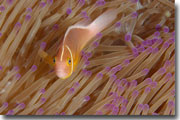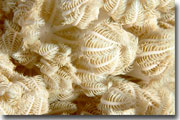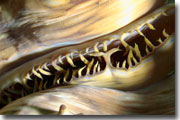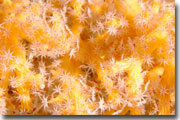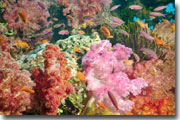
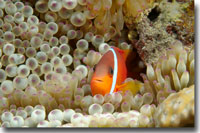 |
Flying to Fiji: The
Fijian islands are located in the south Pacific, and frankly, they�re in
the middle of nowhere. Really. To get there, you have to fly Air Pacific
from Los Angeles. So we started in Seattle at 5 PM, then flew to LA,
then started searching LAX for Air Pacific, finally finding it two
terminals over from |
|
the Alaska terminal
where we came in, sharing a desk
with Qantas. It looked like they shared a desk with Qantas, anyway, but
it turned out the Air Pacific counter is rented from Qantas, and there�s
a very single line you have to stand in. |
We had bought
discounted tickets through Orbitz�we actually found it cheaper to fly
Seattle>LAX>Fiji>Auckland (New Zealand)>LAX>Seattle than going directly to
and from Fiji�but we upgraded to business class (�Tabua class� on Air
Pacific) for $600 each, which meant we had some leg room for the 10 hour
flight. We were very glad we�d done that when we saw how closely packed
people were back in the main cabin. We took off from LAX around midnight,
flew the ten hours, and arrived, staggeringly exhausted, at the crack of
gorgeous Fijian dawn, 5:30 AM, two days later� You lose a day crossing the
International Date Line, and we lost September 25th. It took a
bit of doing to find the driver we�d arranged for�we were going to spend a
few days in a resort before boarding the Nai'a�but we did, and drove the 45
minutes to the resort.
|
The Sonasali
Island Resort was a luxurious and secluded setting that was utterly
wasted on us, as all we wanted to do for the two days we spent there was
sleep. Next time, we�ll fly in the morning of the departure, and go to
the TokaToka, right next to the airport, and sleep there.
|
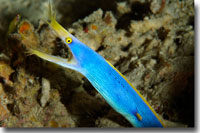 |
|
On Saturday
September 28th, we were driven to the TokaToka from the
Sonasali and met the bus arranged by the Nai'a for the drive to Lautoka,
where the Nai'a was moored. We were met on the bus by Chuck Tribolet,
who�d just spent a week diving on the Nai'a, and was staying for the two
week excursion we were joining. |
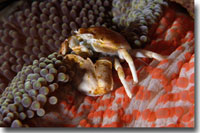 |
He warned us that
once we hit the
boat, everything would happen very fast so that we could get a check-out
dive done and start motoring out of Lautoka. He also told us that we
were lucky: another group had cancelled, and there would only be 8
divers for our trip, instead of the 16 Nai'a can take. |
|
Chuck was right: in
mere seconds after we arrived at the dock, everything had been loaded
and we were underway. We were told to set up our equipment (I put mine
together upside down, in a fog of confusion, but was gently corrected),
but after that, we never needed to fiddle with it again. We motored out
into the |
|
harbor, moored in a shallow murky area, and
did our checkout dive. The visibility (about 15 feet) was terrible, and
my first thought was �oh shit! All that money, and terrible diving!�
(Then I remembered Chuck telling us that this would be far the worst
dive of the trip.) We made the best of it, found a bunch of critters
(sea stars, nudibranchs, and such), and really didn�t stay underwater
long.
The Nai'a is 120
feet, a steel monohull, beautifully
maintained, and feels incredibly solid. Most of the crew has |
 |
|
been on the
boat since it was
brought to Fiji by Rob (as is described on the Nai'a�s web site) and they seem
completely confident in Ravai (the captain) and in each other. I found
this very comforting, as we had occasional rough weather for the entire
trip. (Captain Ravai did make sure we moored for the night in sheltered
areas, whenever he could.) |
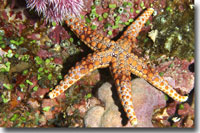 |
I�ll state this
upfront: we had terrible weather. It was windy, it was rainy, it was
cloudy, it was sunny for only one morning the entire two weeks, and it
was rough enough that some passengers needed Dramamine. We were told
this was unusual weather, but I guess it�s happened before during the
same late |
|
September-early October period, as we have
friends who told us later about their similar trip. However, I will also
say that I�d prefer to go back when it�s sunny, but the diving was still
AMAZING, and I�d go back even if it was rough, rainy, and
cloudy for the entire trip again. (But I�d take an extra sweatshirt.) |
|
Our cabin was
comfortable, although not huge. It had its own bathroom (tiny) and we
were told we needed to be careful about fresh water, but not stingy; the
showerhead was extremely meager with water�but who cares, since it was
nice hot water? We had a queen size bed that required a climb to get
into (making it interesting when we were in rough
|
 |
|
patches) and a
well-designed storage area. All the dive
equipment was stored up on the dive deck, and the cameras had a
dedicated camera room. (Of the eight passengers on board, I was the only
non-photographer. The Nai'a has great facilities for photographers�plenty
of room, and two huge freshwater rinse tanks reserved for cameras.) |
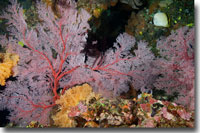 |
The food was
great. There was an early-morning snack before the first dive, and a
chance to sign up for the day�s meals, which usually included a fish
option, a meat option, and a vegetarian option. The schedule pretty much
ran like this: |
|
Snack-dive-breakfast-nap-dive-lunch-nap-dive-snack-night dive-dinner�
sleep. It was possible to dive more than four times a day if you wanted
to, and dive times were fairly flexible. I don�t much like night dives,
but I find dusk dives fascinating (watching the changeover), and several
crepuscular dives were arranged just for Jay and me. |
|
I was worried
before the trip about being so completely out of touch. It turns out
that it�s possible, for a mere $4 (US) per minute, you can use the
Nai'a�s satellite phone. While we didn�t get any news while we were
gone�which was wonderful�we were able to check and make sure our kids
were okay, and didn�t miss us too much. |
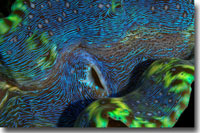 |
|
About packing
for a liveaboard: bring lots of bathing suits�they take a while to
dry�and a few other things. I found a sulu (also called a sarong or a
pareu) and a sweatshirt to be all I really needed most of the time. And
the sweatshirt wouldn�t have been needed if we�d had more sun. Shower
shoes or flip-flops are useful if you don�t want to walk around the boat
barefoot. |
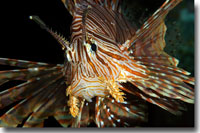 |
The Fijian
culture has a problem with knee exposure�for men or for women�but that
wasn�t a problem on the boat, although during the village visit (more
below) everyone had to wear a sulu. (They seem to make an exception for
tourists, in any case.) Actually, I really like that about Fiji. It was
nifty seeing
|
|
policemen in a neat
organized uniform of
bula shirt (think aloha shirt in more subdued colors) and zigzag-hem
wraparound sulu (think tailored skirt). The Fijians are truly welcoming,
everyone says �bula� (which is a combination of �hello� and �welcome�)
and �bula vinaka� (bula �very much�)�and they mean it.
|
|
The
village
visit: I didn�t go. I had a terrible cold for one day of the trip, and
it happened to be that day. I had visions of giving my cold to the
entire village, and it seemed a good idea not to go. But Jay went, and
and has included
his report. I
know everyone had a good time.
Now, to talk
about the diving: it was incredible, amazing, astonishing� Before this
trip, I�d done a lot of diving in Hawaii�the Kohala Coast mostly (with a
trip to Maui, once). I
|
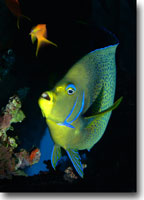 |
|
like diving in
Hawaii, as I see lots of interesting things: the occasional whitetip
reef shark, healthy hard corals, green sea turtles, octopuses, eels, a
humpback whale (once). But diving in Fiji was really different. There
were clouds of fish, especially anthias; there were profusions of
brilliantly colored soft corals�dendronephthya, fans, gorgonians; there
were hundreds of crinoids climbing into the current
and spreading their traps for plankton; there were
schools of
|
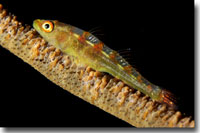 |
barracuda and mackerel and trevally� Anemonefish and
dascyllus taking refuge in their anemones� Huge acropora corals, with
several varieties of small fish hiding among the branches� The huge
variety, the rare and unusual fish and invertebrates, were all
breath-taking. |
|
The Nai'a uses a
really good system for getting to dive sites. The Nai'a itself serves as
a �mother ship,� and it then sends out skiffs to the dive sites. The two
skiff drivers, Little Mo (about 6�6� and well-muscled) and Big Mo
(perhaps a little larger), each take a group to the dive site, or to two
different dive sites within a short ride (2 or 3 minutes) from the boat.
They then cruise around the surface |
| looking for people surfacing
at the end of the dive, then pick them up and take them back to the
boat. (It never took them more than a minute or two to get to us at the
end of the dive, either, even in the roughest water. The one time I
raised my safety sausage, Mo was a little offended I thought he |
 |
|
wouldn�t see me. I was really
only doing it for practice, anyway.) Most people could manage to climb
into the skiffs, but Mo and Mo never minded helping me get in; I just
couldn�t seem to get over the side. They would literally lift me out of
the water (one-handed, too!) and drop me into the bottom of the boat,
then help me get my fins off. |
 |
It�s
possible to join a dive master (Rusi and Richard) for every dive, or
cruise on your own. The dive masters were great at finding requested
subjects for the photographers. A very thorough dive briefing before
each dive allowed for allocation of divers to dive masters, and planning
for what you wanted to |
|
see. The Nai'a diving is not for
beginners, in my opinion. I learned more about diving in those two weeks
than I had in the previous hundred dives: drift diving, mid-water safety
stops, depth management, deep diving, dive planning� The Nai'a assumes
you�re a certified adult and lets you dive your own profile. I asked
about requirements for coming up with 500 psi and the reply was �if you
suck the tank completely dry, let us know so we can inspect the tank��
(There were a few dives where I really wanted to stay down until that
last breath, too!) |
|
I
complained that the first dive�the checkout dive�was pretty bad. Well,
the next dive, the next morning, was to a dive site called �Mello Yello�
for its lush yellow soft corals, which came out in the current. Yes,
lots of current. Fiji is pretty much entirely drift diving, which is one
of the things that makes the Nai'a�s setup perfect. There was a twin dive
site to |
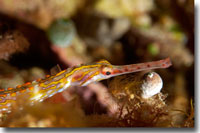 |
|
Mello Yello called Maytag, after its washing-machine-like currents. The
currents on Mello Yello washed across huge healthy yellow and red and
orange and purple soft corals, clouds of anthias cruised the reef,
butterflyfish and angelfish abounded� When I reached the surface, I
asked Kevin�Kevin and Val Tear were the cruise directors�what I had to
do to get a job on the boat. I don�t think he thought I was serious, but
I sure didn�t want to go home, ever, after that dive. And that was only
the beginning. |
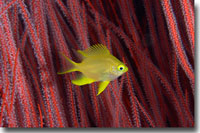 |
In Fiji,
the dive sites are mostly coral �islands� called bommies. These
are roundish and rise from the bottom, which can be thousands of feet
below, although more usually the bottom was at 100 to 150 feet or so.
The currents caused by the tides sweep around the bommies, which is why
most dives are drift dives. One way I warmed up when I felt chilled
|
|
was
to swim into the current for a while. (In fact, despite the excellent
and plentiful food, I lost 5 pounds during the trip.) There was always a
place to duck into the reef and avoid the current�where the
photographers could always be found�but I enjoyed the gorgeous corals
and schools of fish I found out in the current. |
|
North Save-A-Tack, where I spent
the entire dive in the Kansas shallow flats (named for the golden
corals): I saw a clown triggerfish, and a very large emperor angelfish�
I watched a small Napoleon wrasse being cleaned, standing on his head,
by a group of small cleaner wrasses. And I saw
three lionfish, including |
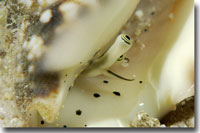 |
|
one with his fins fully spread
and looking just like a bird sunning himself�
New Teton:
I watched three jacks hunt back and forth across the top of the reef,
while the anthias ducked into the coral and re-emerged after each pass.
A large barracuda swam by during the dive. It was at New Teton that I
learned to use a |
 |
reef hook,
which is why I was watching the jacks hunt across the top. Currents
swept over the top, and it was hard to stay in one place, even swimming
as hard as I could, so Kevin loaned me his reef hook, and I �flew� in
the current until my air was almost gone. When I unhooked the reef hook
to ascend, I went |
|
flying off the reef and drifted
about 200 yards from the bommie during my 5 minute safety stop� (Yes,
you must be able to do a mid-water safety stop without an ascent line.) |
|
Schoolhouse: at Schoolhouse, there were either three large gray reef
sharks, or a single shark who hung around to watch us� A sleeping
whitetip in the sand, and lots of barracuda, including a line of
yellowtail barracuda.
Little
Thumb (also called Peewee): Jay and I did a |
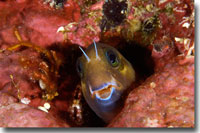 |
|
crepuscular
(dusk) dive at Little Thumb. When I found two cleaner shrimp looking for
customers at the edge of a cavern, I held my hand still for them. One
jumped right onto my hand and cleaned the cuticles (which tickled). I
was bored long before he was done. We found several banded pipefish, and
lots of shrimp, nudibranchs, and a seven-armed red linckia sea star. |
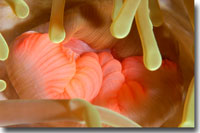 |
Wakaya:
this is the house reef for a luxury resort, and unfortunately, it�s been
badly bleached. We dove at Wakaya three times, though, because we found
unusual creatures all day� There were blue ribbon eels (lots of them),
leaf scorpionfish, tassled scorpionfish, rabbitfish, gorgeous parrotfish
with color patterns |
|
found in none
of the fish ID books. I watched a titan triggerfish blowing sand to hunt
for crustaceans. When Jay and I went out for a crepuscular dive, there
were about a dozen lionfish out hunting across the top of the reef.
While he photographed them, I watched an octopus hunt, while a goatfish
waited patiently next to it for the scraps. Wakaya had a warm current
across the top of the reef; it was in the same spot all day, though, and
it�s my belief it�s a hot spring, which might explain some of the
bleaching at Wakaya. |
| Nigali
Pass: this is a �valley� between two bommies. The current sweeps
through, and there are spots on the side (�the bleachers�) where you can
take refuge from the current. Here, Kevin anchored a bucket with frozen
fish parts, and we waited for the sharks to come in. While 6 or 7 gray
reef sharks came to feed, several dozen red bass and a large black
trevally got |
 |
|
most of the
food. The sharks were very calm about the food, though; they would
simply cruise in and gently (but firmly) push the other fish out of the
way to get what they wanted. I ended up about five feet away from the
bucket (I�d intended to be farther away!) and never felt at all
threatened. These were very relaxed and self-confident sharks, and they
didn�t think people were interesting. Several of the sharks had remoras,
and one had a large isopod. After the food was gone, I let go of my
spot, and the current swept me up the slope and over the reef flat,
where I found schools of copper sweepers amid fields of lettuce coral, a
pair of blackfin dartfish, and a pair of reticulated butterflyfish. |
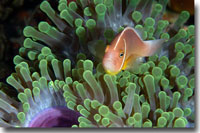 |
Mount
Mutiny: we dove twice at Mount Mutiny. We saw several hawksbill turtles,
one of which was so oblivious to our presence that Rusi held broken
coral bits for it while it nibbled the sponges and algae off the coral.
Small wrasses waited underneath the turtles for the scraps. There were
huge schools of anthias (which I actually came to take
for granted), and a |
|
trumpetfish
shadowing a parrotfish, and a school of Heller�s barracuda and
surgeonfish. I also saw a midnight angelfish�gorgeous. The hanging coral
at 95 feet were spectacular. |
|
E6: the
famous E6 has suffered some minor bleaching, we were told. It was
nonetheless gorgeous, and we dove there four times without really seeing
all of it. There were spawning damselfish and shrimp gobies. Up in the
rubbly shallows, as I did my safety stop at the end of the first dive at
E6, I watched a school of 2-foot mackerel get themselves cleaned by
cleaner |
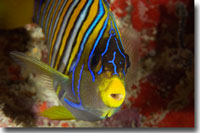 |
|
wrasses, who entered their mouths and gills as they stood on their
tails, flushing black. When they were done, they shook their tails and
turned back to silver, swimming off one by one. |
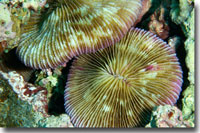 |
At E6, Chuck Tribolet and I actually managed to surprise the crew of the
Nai'a. Over dinner, we plotted a pre-dawn dive to E6� got the crew�s
agreement� and then actually got up at 4AM and did it. Many had planned;
none (before us) had actually done it. We were anchored in the lee of
the reef at E6, so we (quietly) entered from the back of the
|
|
Nai'a, swam along the boat and then along the anchor line, then explored
E6�s �cathedral� area. It was VERY different from what we saw there
during the day. There were white and orange anemones that had crawled
out onto the sea fans, schools of cardinal and squirrel fish in the
currents off the reef, swimmer crabs, many brittle stars out hunting�
I�d wanted to go out in the pre-dawn after reading about it; this was
the first time I found someone willing to go with me. (Thanks, Chuck.)
It was lovely to come up into the sunrise at the end of the dive, and
the Nai'a�s crew was there waiting for us, to help us onto the boat.
|
|
Later that day, during a night dive in the E6 cathedral, I saw a pair of
ghost pipefish pretending to be algae�at about 45 feet, in a dark
cavern. I fell for the camouflage, and it wasn�t until the next morning
that I realized that I
hadn�t seen algae at all, but ghost pipefish. This resulted in grumpy
photographers, and I still feel somewhat guilty about it. |
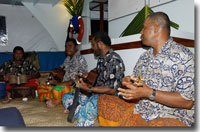 |
Mello Yello: there
were groups of sergeant majors in their breeding colors, twenty or more
in several protected areas, guarding their eggs. And huge schools of
anthias�and massive, colorful tree corals�
|
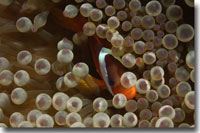 |
Go Mo Reef: Go Mo Reef was a new site, spotted as a potential site by
Mo, who found my favorite dive site of the trip. Go Mo was near
Lighthouse, but it had clearly never been dived before (if it was, they
were very careful divers� as I hope we were). The sea fans had no broken
tips; unbroken stony corals and huge schools of unafraid fish. I saw a
pair of clown |
|
triggerfish, a green-sided eel, longnose filefish, a
humphead wrasse, and bignose unicornfish (a great name). The sea fans
were huge and colorful; the tree corals brilliant and glowing in health.
We dove Go Mo Reef three times�currents from two directions, and in
slack current. While the current was a bit on the fierce side, the
corals definitely loved it! |
|
Then, there was the Crown Massacre� Just a few miles (maybe less!) from
Go Mo Reef, we found another new dive site, now nicknamed the Crown
Massacre. Tens of Crown of Thorns sea stars devouring a dead and
bleached reef� We did see a few interesting critters: a single anemone
with two different species of anemonefish; nudibranchs and |
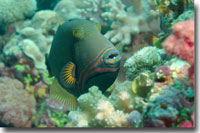 |
|
flatworms,
midnight angels, and a harem of what appeared to me to be flame wrasses,
with one male and four females. A quick check of the fish id books,
however, told me that flame wrasses are only found in Hawaii (where I
have seen them), and no one else saw them, so they�ll have to remain
unidentified. (There are a few wrasses that have juvenile stages in
which they resemble flame wrasses�but that doesn�t explain the male that
was flaring his fins.) |
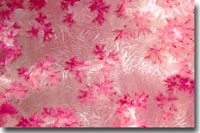 |
Cat�s Meow: this dive site really was everything it was supposed to be:
fourteen harlequin sweetlips, lined up at a cleaning station at the base
of the bommies (in about 70 feet of water)� Two huge groupers I didn�t
even try to identify (all those big spotted groupers look alike to me,
I�m afraid); a pair of elongate surgeonfish; a tiny green bubble-tipped
anemone with even-tinier |
|
anemonefish; a big tuna; and a school of
prowling blue trevallies. AND gorgeous hard and soft coral on the top.
From Cat�s Meow, we went back again to Mello Yello, where we saw a huge
school of fusiliers and a lone barracuda. There was a huge clump of
featherdusters, about twenty of them in a small area; large schools of
anthias; and a pretty folded and swirling anemone with green spots on
its base and unusually large anemonefish in its protection.
|
|
Our final dives of the trip were at Golden Sunset, where we sheltered
from the wind and rough weather in the lee of the reef. While we dove,
in fact, a boat overturned just outside of Lautoka harbor and several
fishermen drowned in the rough conditions. It was relatively calm at
Golden Sunset, however, because of the protection of the reef. |
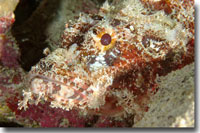 |
|
At Golden Sunset, there were two giant morays sharing a hole, being
cleaned. They were very shy, ducking back into their hole if I came too
close. On the third dive there, when I tried to show Rusi the divemaster
the eels, only one of them was willing to be seen. For quite a while, I
watched an ornate prawn goby and his prawn work on their burrow. The
prawn would bring out one piece of coral sand, carry in a different one,
then come out with yet another piece of sand� It was like watching
someone build a stone wall, testing different stones to see how they fit
into the wall� Golden Sunset was named for its masses of yellow soft
corals, but there were soft corals in all colors. It was a gorgeous dive
site; we got a brief glimpse of sun streaming through the brightly
colored Dendronephthya corals�it made me wish I could do glass
sculptures, as that might allow me to show someone else what those were
like! |
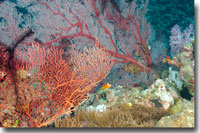 |
A school of unicornfish amused me by pointing themselves into the steady
(but not overwhelming) current; two of us snuck up on a school of
sleeping yellowtail barracuda� it was a good finish to a wonderful trip. |
|
After Golden Sunset, we commenced to motoring back to Lautoka, cleaning
up, washing wet suits, packing� We docked overnight in Lautoka harbor,
and left the boat the next morning. We plan to return soon.
RETURN to Jay
Torborg's Scuba Diving Page |
|
















